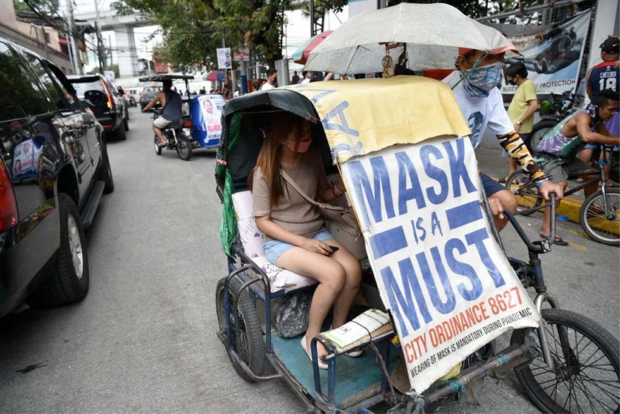OCTA sees Metro Manila COVID cases rising to 400 to 500 by end of June

A passenger sits inside a tricycle covered with a reminder to wear a mask, part of COVID-19 health protocols, in Manila. (File photo by Agence France-Presse)
MANILA, Philippines — The daily COVID-19 cases in Metro Manila could increase to as much as 400 to 500 by the end of June, the independent analytics group OCTA Research warned on Tuesday.
While Metro Manila remains at low risk classification, OCTA Research fellow Dr. Guido David said these could escalate to moderate risk classification by next week.
David said COVID-19 cases in the region increased from 10 percent to 53 percent the past week, adding that the reproduction rate was now at 1.59 percent.
According to him, the number of COVID-19 cases in Metro Manila was at 188 on Monday while the positivity rate was at 2.7 percent.
“In fact, our projection by the end of June is that it may reach 400 to 500,” he said at the Laging Handa briefing, referring to the COVID-19 cases per day in Metro Manila.
Article continues after this advertisement”So, the increase in the number of cases is accelerating because we used to only have about 65 cases per day,” he added.
Article continues after this advertisementAlert Level 1 until June 15
For the rest of the country, he said a “low thousand cases per day” would be possible.
“Hopefully, it will not reach 1,000 cases per day in Metro Manila but that is still a possibility,” he said.
David said there was no need yet to escalate the COVID-19 classification to alert level 2 in Metro Manila but this could be possible “within the next few weeks.”
Metro Manila remains under the most relaxed alert level 1 until June 15.The waning immunity of the general population due to a low first booster coverage amid the entry of new Omicron subvariants may be blamed for the noted growth in new COVID-19 infections in Metro Manila and other regions, according to Health Undersecretary Maria Rosario Vergeire.
The health official pinned down three factors that may have contributed to the rise in cases: detection of more contagious Omicron sublineages, increased mobility and a sluggish booster uptake.
“We are considering the entry of subvariants in the country. We initially detected the BA.2.12.1 and then, we detected BA.4 and BA.5. These subvariants are more transmissible compared to the original Omicron variant (B.1.1.529),” Vergeire said in a radio interview on Tuesday.
She also likened the current mobility of the people to prepandemic times, where “everyone is leaving their homes,” even as most are still not up-to-date with their booster shots, leading their “wall of immunity” to go down.
“The immunity of the population is starting to wane because of the low uptake of boosters,” Vergeire said.
RELATED STORIES
Daily COVID-19 cases up by 14% in NCR but still at low risk, says OCTA
NCRPO seeks public cooperation if Metro Manila’s COVID-19 alert is raised to Level 2
OCTA Research says new COVID-19 cases in Metro Manila ‘have accelerated’